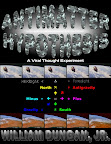| Past « | Present Δ | Future » |
| North N | Up ↑ | |
| West – | Origin/Location ≈ | East + |
| Down ↓ | South $ |
Within the context of space-time, the compass rose is a tool used to specify the location of any place on earth, measuring latitude North or South, and measuring longitude East or West. In addition, a few common terms represent height Up or Down. Elevation measures distance of the surface above sea level. Depth measures distance in water below the surface. And altitude measures distance in the air above the ground or water surface.
Without a fixed frame of reference, the four dimensions of space-time remain ambiguous. The standard terms used to designate an absolute point of reference or origin on earth include the following: equator, prime meridian, sea level, Greenwich Mean Time (GMT), and calendar.
Whereas the transition between North and South, between Up and Down, and between Past and Future seems continuous; our notions of East and West don’t mix, like oil and water. This characteristic is no accident. Between some extremes lie shades of gray, but other extremes are black and white.
Time operates in peculiar ways. Only the Present actually ever exists, and it is eternal. The Past can’t be changed, and the Future never arrives. Despite appearances space and time are inseparable. Time, as we experience it, is measured by the rotation, orbit, and procession of our planet Earth against the backdrop of the stars, including Sol, our sun.
Metric dimensions of distance, mass, and volume come in the units: meters, grams, and liters. Roughly equivalent English values come in the units: inches or feet or yards or miles, ounces or pounds or tons, and teaspoons or tablespoons or cups or quarts or gallons.
Time is measured in the units: seconds, minutes, hours, days, weeks, months, years, centuries, and millennia.
On vastly different scales are the special purpose units: angstroms and light-years.









No comments:
Post a Comment